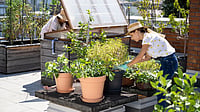Across the world, homeowners, landscapers, and community gardeners are rethinking their choices of what to plant. Instead of relying solely on showy imported ornamentals, more and more people are turning
toward native plants—species that have evolved naturally in a particular region over thousands of years. What was once seen as a niche movement embraced mainly by ecologists is now going mainstream, transforming suburban yards, urban rooftops, and even public parks.
Global gardening shift
From the drought-prone suburbs of California to the rain-soaked villages of India, a growing awareness of climate change, biodiversity loss, and water scarcity is prompting gardeners to reconsider their plant palettes. In Australia, local councils now encourage homeowners to use native eucalyptus, bottlebrush, and grevillea to create resilient, wildlife-friendly gardens. In Europe, residents are planting wildflowers such as cornflowers, poppies, and oxeye daisies in place of thirsty lawns. Even in bustling cities like New York, Tokyo, and Nairobi, rooftop gardens filled with native grasses and shrubs are becoming symbols of sustainable living.
The appeal is simple: native plants are uniquely adapted to their home environments. They require less water, fewer fertilizers, and minimal pest control compared to many exotic species. That makes them a smart choice for homeowners who want beautiful, low-maintenance gardens that also support the environment.
Ecological benefits
Perhaps the most compelling argument for native planting is its impact on biodiversity. Insects, birds, and pollinators rely heavily on native flora for survival. A monarch butterfly, for example, depends on milkweed species native to North America to complete its lifecycle. In many parts of the world, pollinator populations are in steep decline due to habitat loss, pesticide use, and urban expansion. By planting natives, gardeners essentially rebuild small pockets of habitat that sustain local food webs.
Dr. Anika Mehta, an ecologist based in Delhi, describes it as “rewilding our own backyards.” She notes that when people plant imported ornamentals like petunias or hybrid roses, pollinators often can’t use them as a food source. “A yard filled with native plants is more than decoration,” she explains. “It’s a lifeline for bees, butterflies, and birds.”
Climate resilience















